2007 ISUZU KB P190 jump cable
[x] Cancel search: jump cablePage 617 of 6020

5A-24 BRAKE CONTROL SYSTEM
Computer System Service Precautions
The Anti-lock Brake System and Electronic Brake-force
Distribution interfaces directly with the Electronic
Hydraulic Control Unit (EHCU) which is a control
computer that is similar in some regards to the Engine
Control Module. These modules are designed to
withstand normal current draws associated with vehicle
operation. However, care must be taken to avoid
overloading any of the EHCU circuits. In testing for
opens or shorts, do not ground or apply voltage to any
of the circuits unless instructed to do so by the
appropriate diagnostic procedure. These circuits should
only be tested with a high impedance multimeter
5-8840-0366-0 or special tools as described in this
section. Power should never be removed or applied to
any control module with the ignition in the “ON” position.
Before removing or connecting battery cables, fuses or
connectors, always turn the ignition switch to the “OFF”
position.
General Service Precautions
The following are general precautions which should be
observed when servicing and diagnosing the Anti-lock
Brake System and/or other vehicle systems. Failure to
observe these precautions may result in Anti-lock Brake
System and Electronic Brake-force Distribution
damage.
• If welding work is to be performed on the vehicle using an electric arc welder, the EHCU and valve
block connectors should be disconnected before the
welding operation begins.
• The EHCU and valve block connectors should never be connected or disconnected with the
ignition “ON”.
Note:
• If only rear wheels are rotated using jacks or drum tester, the system will diagnose a speed sensor
malfunction and the “ABS and Brake” warning lamp
will illuminate. But actually no trouble exists. W hen
the DTC is not detected and the ABS and BRAKE
warning lamp is on, “How to erase code” is
performed and an ABS and BRAKE warning lamp
are off.
If the battery has been discharged
The engine may stall if the battery has been completely
discharged and the engine is started via jumper cables.
This is because the Anti-lock Brake System (ABS) and
Electronic Brake-force Distribution (EBD) System
requires a large quantity of electricity. In this case, wait
until the battery is recharged, or set the ABS and EBD
to a non-operative state by removing the fuse for the
ABS. After the battery has been recharged, stop the
engine and install the ABS fuse. Start the engine again,
and confirm that the ABS warning Lamp does not light.
Note on Intermittents
As with virtually any electronic system, it is difficult to
identify an intermittent failure. In such a case duplicating
the system malfunction during a test drive or a good
description of vehicle behavior from the customer may
be helpful in locating a “most likely” failed component or
circuit. The symptom diagnosis chart may also be
useful in isolating the failure. Most intermittent
problems are caused by faulty electrical connections or
wiring. W hen an intermittent failure is encountered,
check suspect circuits for:
• Suspected harness damage.
• Poor mating of connector halves or terminals not fully seated in the connector body (backed out).
• Improperly formed or damaged terminals.
Test Driving ABS Complaint Vehicles
If there has been an abnormality in the lighting pattern
of the “ABS” warning lamp, the fault can be located in
accordance with the “DIAGNOSIS BY “ABS” W ARNING
LAMP ILLUMINATION PATTERN”. Although such
problems can be detected by the driver as a vehicle
symptom, it is still necessary to perform a test drive
following the test procedure mentioned below, in order
to reproduce the symptom for problem diagnosis on a
symptom basis:
1. Start the engine and make sure that the “ABS” W /L
goes OFF. If the W /L remains ON, it means that
the Diagnostic Trouble Code (DTC) is stored.
Therefore, read the code and locate the fault.
Note: The DTC cannot be cleared if the vehicle speed
does not exceed about 10km/h (6mph) at DTC, even
though the repair operation is completed.
2. Start the vehicle and accelerate to about 30 km/h (19 mph) or more.
3. Slowly brake and stop the vehicle completely.
4. Then restart the vehicle and accelerate to about 40 km/h (25 mph) or more.
5. Brake at a time so as to actuate the ABS and stop the vehicle.
6. Be cautious of abnormality during the test. If the W /L is actuated while driving, read the DTC and
locate the fault.
7. If the abnormality is not reproduced by the test, make best efforts to reproduce the situation
reported by the customer.
8. If the abnormality has been detected, repair in accordance with the “SYMPTOM DIAGNOSIS”.
Note:
• Be sure to perform a test drive on a wide, even road
with light traffic.
• If an abnormality is detected, be sure to suspend the test and start trouble diagnosis at once.
BACK TO CHAPTER INDEX
TO MODEL INDEX
ISUZU KB P190 2007
Page 1194 of 6020
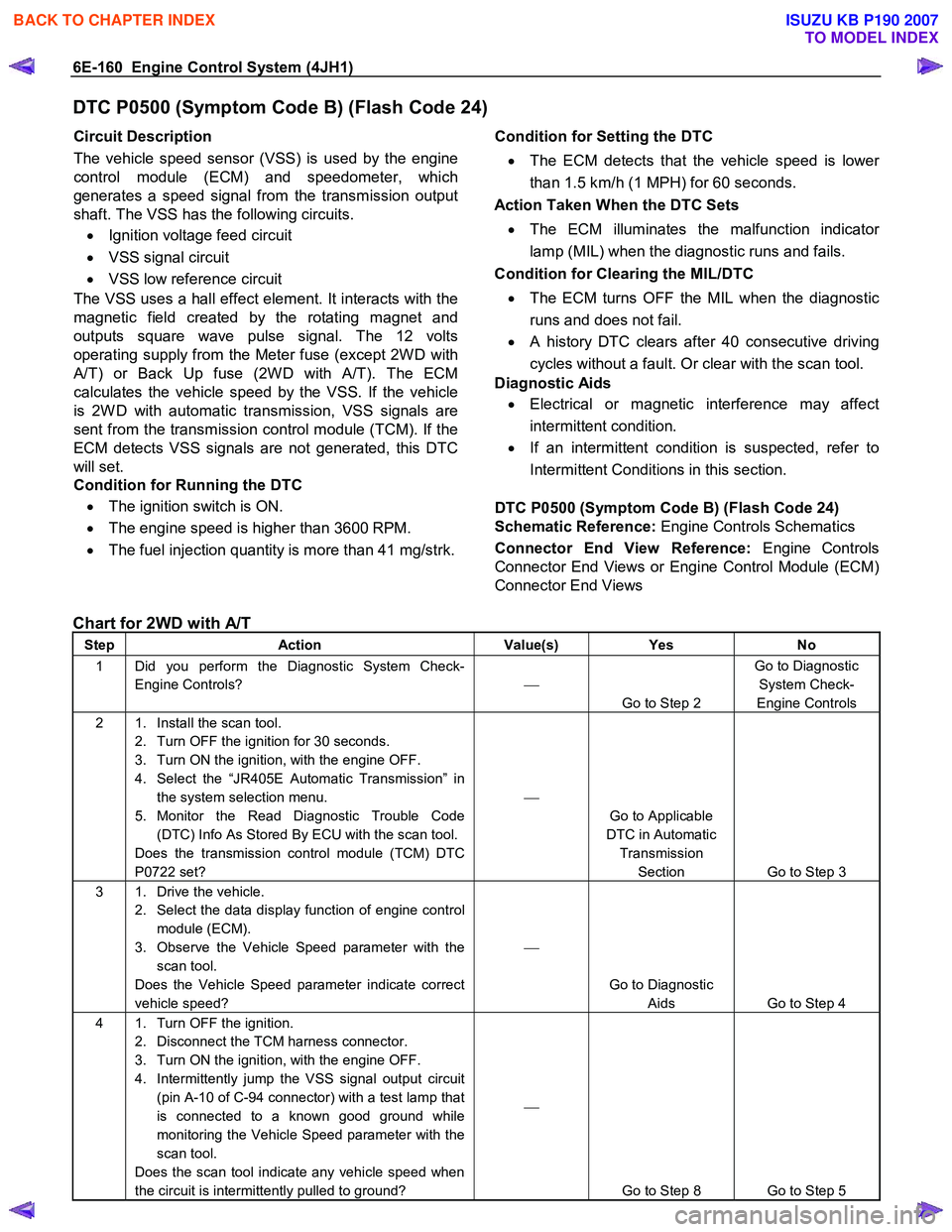
6E-160 Engine Control System (4JH1)
DTC P0500 (Symptom Code B) (Flash Code 24)
Circuit Description
The vehicle speed sensor (VSS) is used by the engine
control module (ECM) and speedometer, which
generates a speed signal from the transmission output
shaft. The VSS has the following circuits.
• Ignition voltage feed circuit
• VSS signal circuit
• VSS low reference circuit
The VSS uses a hall effect element. It interacts with the
magnetic field created by the rotating magnet and
outputs square wave pulse signal. The 12 volts
operating supply from the Meter fuse (except 2W D with
A/T) or Back Up fuse (2W D with A/T). The ECM
calculates the vehicle speed by the VSS. If the vehicle
is 2W D with automatic transmission, VSS signals are
sent from the transmission control module (TCM). If the
ECM detects VSS signals are not generated, this DTC
will set.
Condition for Running the DTC
• The ignition switch is ON.
• The engine speed is higher than 3600 RPM.
• The fuel injection quantity is more than 41 mg/strk.
Condition for Setting the DTC
• The ECM detects that the vehicle speed is lowe
r
than 1.5 km/h (1 MPH) for 60 seconds.
Action Taken When the DTC Sets
• The ECM illuminates the malfunction indicato
r
lamp (MIL) when the diagnostic runs and fails.
Condition for Clearing the MIL/DTC
• The ECM turns OFF the MIL when the diagnostic
runs and does not fail.
• A history DTC clears after 40 consecutive driving
cycles without a fault. Or clear with the scan tool.
Diagnostic Aids
• Electrical or magnetic interference may affect
intermittent condition.
• If an intermittent condition is suspected, refer to
Intermittent Conditions in this section.
DTC P0500 (Symptom Code B) (Flash Code 24)
Schematic Reference: Engine Controls Schematics
Connector End View Reference: Engine Controls
Connector End Views or Engine Control Module (ECM)
Connector End Views
Chart for 2WD with A/T
Step Action Value(s) Yes No
1 Did you perform the Diagnostic System Check-
Engine Controls?
Go to Step 2 Go to Diagnostic
System Check-
Engine Controls
2 1. Install the scan tool. 2. Turn OFF the ignition for 30 seconds.
3. Turn ON the ignition, with the engine OFF.
4. Select the “JR405E Automatic Transmission” in the system selection menu.
5. Monitor the Read Diagnostic Trouble Code (DTC) Info As Stored By ECU with the scan tool.
Does the transmission control module (TCM) DTC
P0722 set?
Go to Applicable
DTC in Automatic Transmission Section Go to Step 3
3 1. Drive the vehicle. 2. Select the data display function of engine control module (ECM).
3. Observe the Vehicle Speed parameter with the scan tool.
Does the Vehicle Speed parameter indicate correct
vehicle speed?
Go to Diagnostic Aids Go to Step 4
4 1. Turn OFF the ignition. 2. Disconnect the TCM harness connector.
3. Turn ON the ignition, with the engine OFF.
4. Intermittently jump the VSS signal output circuit (pin A-10 of C-94 connector) with a test lamp that
is connected to a known good ground while
monitoring the Vehicle Speed parameter with the
scan tool.
Does the scan tool indicate any vehicle speed when
the circuit is intermittently pulled to ground?
Go to Step 8 Go to Step 5
BACK TO CHAPTER INDEX
TO MODEL INDEX
ISUZU KB P190 2007
Page 1203 of 6020
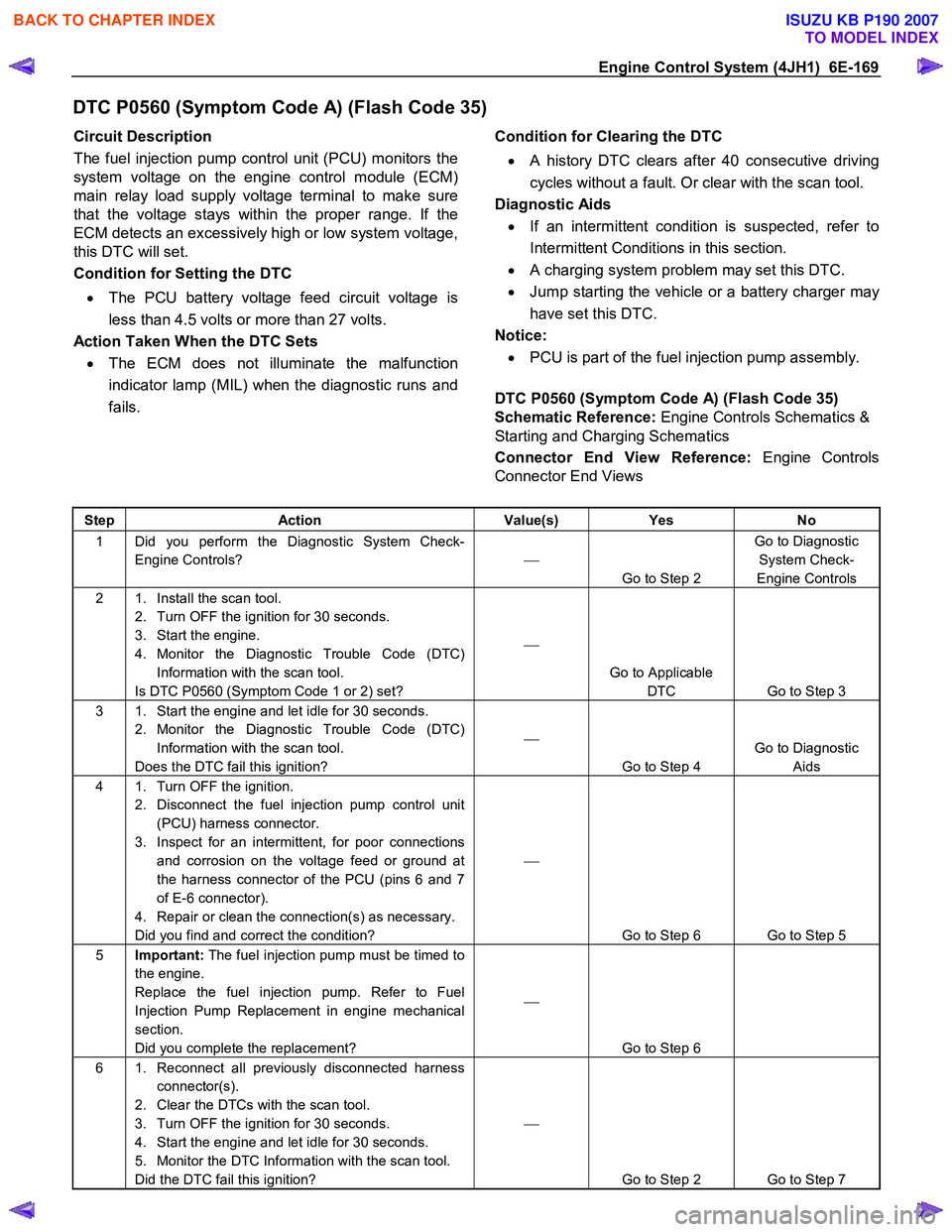
Engine Control System (4JH1) 6E-169
DTC P0560 (Symptom Code A) (Flash Code 35)
Circuit Description
The fuel injection pump control unit (PCU) monitors the
system voltage on the engine control module (ECM)
main relay load supply voltage terminal to make sure
that the voltage stays within the proper range. If the
ECM detects an excessively high or low system voltage,
this DTC will set.
Condition for Setting the DTC
• The PCU battery voltage feed circuit voltage is
less than 4.5 volts or more than 27 volts.
Action Taken When the DTC Sets
• The ECM does not illuminate the malfunction
indicator lamp (MIL) when the diagnostic runs and
fails.
Condition for Clearing the DTC
• A history DTC clears after 40 consecutive driving
cycles without a fault. Or clear with the scan tool.
Diagnostic Aids
• If an intermittent condition is suspected, refer to
Intermittent Conditions in this section.
• A charging system problem may set this DTC.
• Jump starting the vehicle or a battery charger may
have set this DTC.
Notice:
• PCU is part of the fuel injection pump assembly.
DTC P0560 (Symptom Code A) (Flash Code 35)
Schematic Reference: Engine Controls Schematics &
Starting and Charging Schematics
Connector End View Reference: Engine Controls
Connector End Views
Step Action Value(s) Yes No
1 Did you perform the Diagnostic System Check-
Engine Controls?
Go to Step 2 Go to Diagnostic
System Check-
Engine Controls
2 1. Install the scan tool. 2. Turn OFF the ignition for 30 seconds.
3. Start the engine.
4. Monitor the Diagnostic Trouble Code (DTC) Information with the scan tool.
Is DTC P0560 (Symptom Code 1 or 2) set?
Go to Applicable DTC Go to Step 3
3 1. Start the engine and let idle for 30 seconds. 2. Monitor the Diagnostic Trouble Code (DTC) Information with the scan tool.
Does the DTC fail this ignition?
Go to Step 4 Go to Diagnostic
Aids
4 1. Turn OFF the ignition. 2. Disconnect the fuel injection pump control unit (PCU) harness connector.
3. Inspect for an intermittent, for poor connections and corrosion on the voltage feed or ground at
the harness connector of the PCU (pins 6 and 7
of E-6 connector).
4. Repair or clean the connection(s) as necessary.
Did you find and correct the condition?
Go to Step 6 Go to Step 5
5 Important: The fuel injection pump must be timed to
the engine.
Replace the fuel injection pump. Refer to Fuel
Injection Pump Replacement in engine mechanical
section.
Did you complete the replacement?
Go to Step 6
6 1. Reconnect all previously disconnected harness connector(s).
2. Clear the DTCs with the scan tool.
3. Turn OFF the ignition for 30 seconds.
4. Start the engine and let idle for 30 seconds.
5. Monitor the DTC Information with the scan tool.
Did the DTC fail this ignition?
Go to Step 2 Go to Step 7
BACK TO CHAPTER INDEX
TO MODEL INDEX
ISUZU KB P190 2007
Page 1232 of 6020
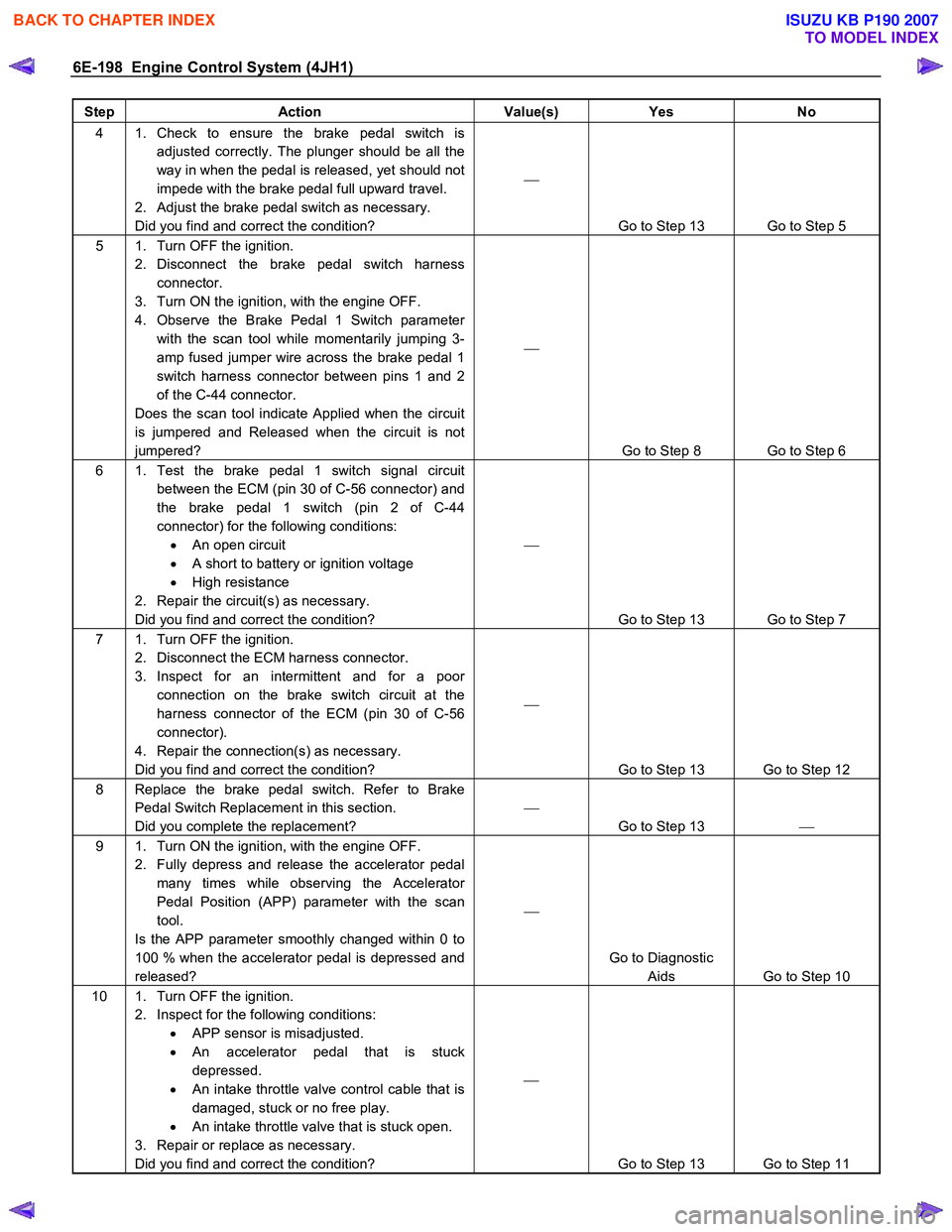
6E-198 Engine Control System (4JH1)
Step Action Value(s) Yes No
4 1. Check to ensure the brake pedal switch is
adjusted correctly. The plunger should be all the
way in when the pedal is released, yet should not
impede with the brake pedal full upward travel.
2. Adjust the brake pedal switch as necessary.
Did you find and correct the condition?
Go to Step 13 Go to Step 5
5 1. Turn OFF the ignition. 2. Disconnect the brake pedal switch harness connector.
3. Turn ON the ignition, with the engine OFF.
4. Observe the Brake Pedal 1 Switch parameter with the scan tool while momentarily jumping 3-
amp fused jumper wire across the brake pedal 1
switch harness connector between pins 1 and 2
of the C-44 connector.
Does the scan tool indicate Applied when the circuit
is jumpered and Released when the circuit is not
jumpered?
Go to Step 8 Go to Step 6
6 1. Test the brake pedal 1 switch signal circuit between the ECM (pin 30 of C-56 connector) and
the brake pedal 1 switch (pin 2 of C-44
connector) for the following conditions: • An open circuit
• A short to battery or ignition voltage
• High resistance
2. Repair the circuit(s) as necessary.
Did you find and correct the condition?
Go to Step 13 Go to Step 7
7 1. Turn OFF the ignition. 2. Disconnect the ECM harness connector.
3. Inspect for an intermittent and for a poor connection on the brake switch circuit at the
harness connector of the ECM (pin 30 of C-56
connector).
4. Repair the connection(s) as necessary.
Did you find and correct the condition?
Go to Step 13 Go to Step 12
8 Replace the brake pedal switch. Refer to Brake Pedal Switch Replacement in this section.
Did you complete the replacement?
Go to Step 13
9 1. Turn ON the ignition, with the engine OFF.
2. Fully depress and release the accelerator pedal many times while observing the Accelerator
Pedal Position (APP) parameter with the scan
tool.
Is the APP parameter smoothly changed within 0 to
100 % when the accelerator pedal is depressed and
released?
Go to Diagnostic Aids Go to Step 10
10 1. Turn OFF the ignition. 2. Inspect for the following conditions: • APP sensor is misadjusted.
• An accelerator pedal that is stuck
depressed.
• An intake throttle valve control cable that is
damaged, stuck or no free play.
• An intake throttle valve that is stuck open.
3. Repair or replace as necessary.
Did you find and correct the condition?
Go to Step 13 Go to Step 11
BACK TO CHAPTER INDEX
TO MODEL INDEX
ISUZU KB P190 2007
Page 1277 of 6020
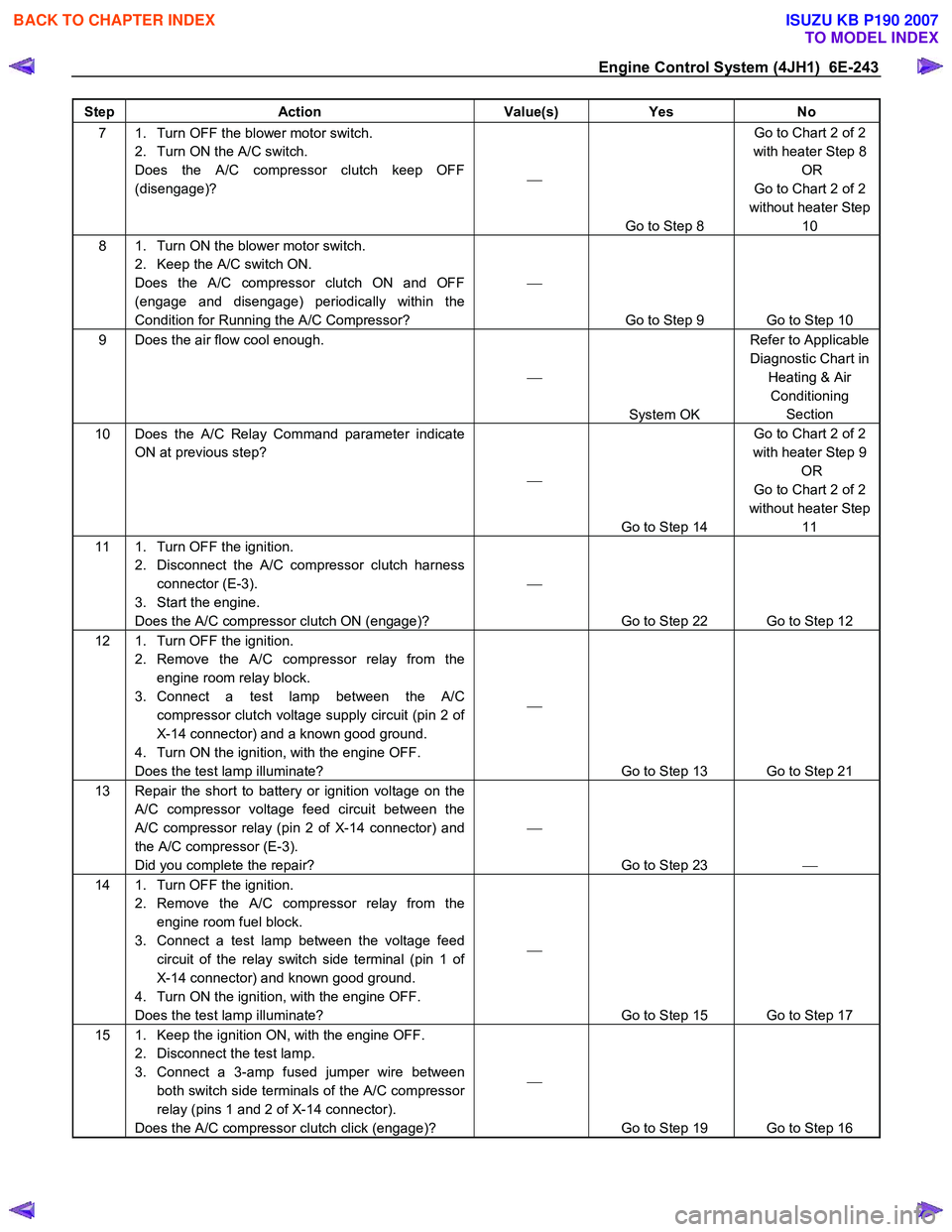
Engine Control System (4JH1) 6E-243
Step Action Value(s) Yes No
7 1. Turn OFF the blower motor switch.
2. Turn ON the A/C switch.
Does the A/C compressor clutch keep OFF
(disengage)?
Go to Step 8 Go to Chart 2 of 2
with heater Step 8 OR
Go to Chart 2 of 2
without heater Step 10
8 1. Turn ON the blower motor switch. 2. Keep the A/C switch ON.
Does the A/C compressor clutch ON and OFF
(engage and disengage) periodically within the
Condition for Running the A/C Compressor?
Go to Step 9 Go to Step 10
9 Does the air flow cool enough.
System OK Refer to Applicable
Diagnostic Chart in Heating & Air Conditioning Section
10 Does the A/C Relay Command parameter indicate ON at previous step?
Go to Step 14 Go to Chart 2 of 2
with heater Step 9 OR
Go to Chart 2 of 2
without heater Step 11
11 1. Turn OFF the ignition. 2. Disconnect the A/C compressor clutch harness connector (E-3).
3. Start the engine.
Does the A/C compressor clutch ON (engage)?
Go to Step 22 Go to Step 12
12 1. Turn OFF the ignition. 2. Remove the A/C compressor relay from the engine room relay block.
3. Connect a test lamp between the A/C compressor clutch voltage supply circuit (pin 2 of
X-14 connector) and a known good ground.
4. Turn ON the ignition, with the engine OFF.
Does the test lamp illuminate?
Go to Step 13 Go to Step 21
13 Repair the short to battery or ignition voltage on the A/C compressor voltage feed circuit between the
A/C compressor relay (pin 2 of X-14 connector) and
the A/C compressor (E-3).
Did you complete the repair?
Go to Step 23
14 1. Turn OFF the ignition.
2. Remove the A/C compressor relay from the engine room fuel block.
3. Connect a test lamp between the voltage feed circuit of the relay switch side terminal (pin 1 of
X-14 connector) and known good ground.
4. Turn ON the ignition, with the engine OFF.
Does the test lamp illuminate?
Go to Step 15 Go to Step 17
15 1. Keep the ignition ON, with the engine OFF. 2. Disconnect the test lamp.
3. Connect a 3-amp fused jumper wire between both switch side terminals of the A/C compressor
relay (pins 1 and 2 of X-14 connector).
Does the A/C compressor clutch click (engage)?
Go to Step 19 Go to Step 16
BACK TO CHAPTER INDEX
TO MODEL INDEX
ISUZU KB P190 2007
Page 1278 of 6020
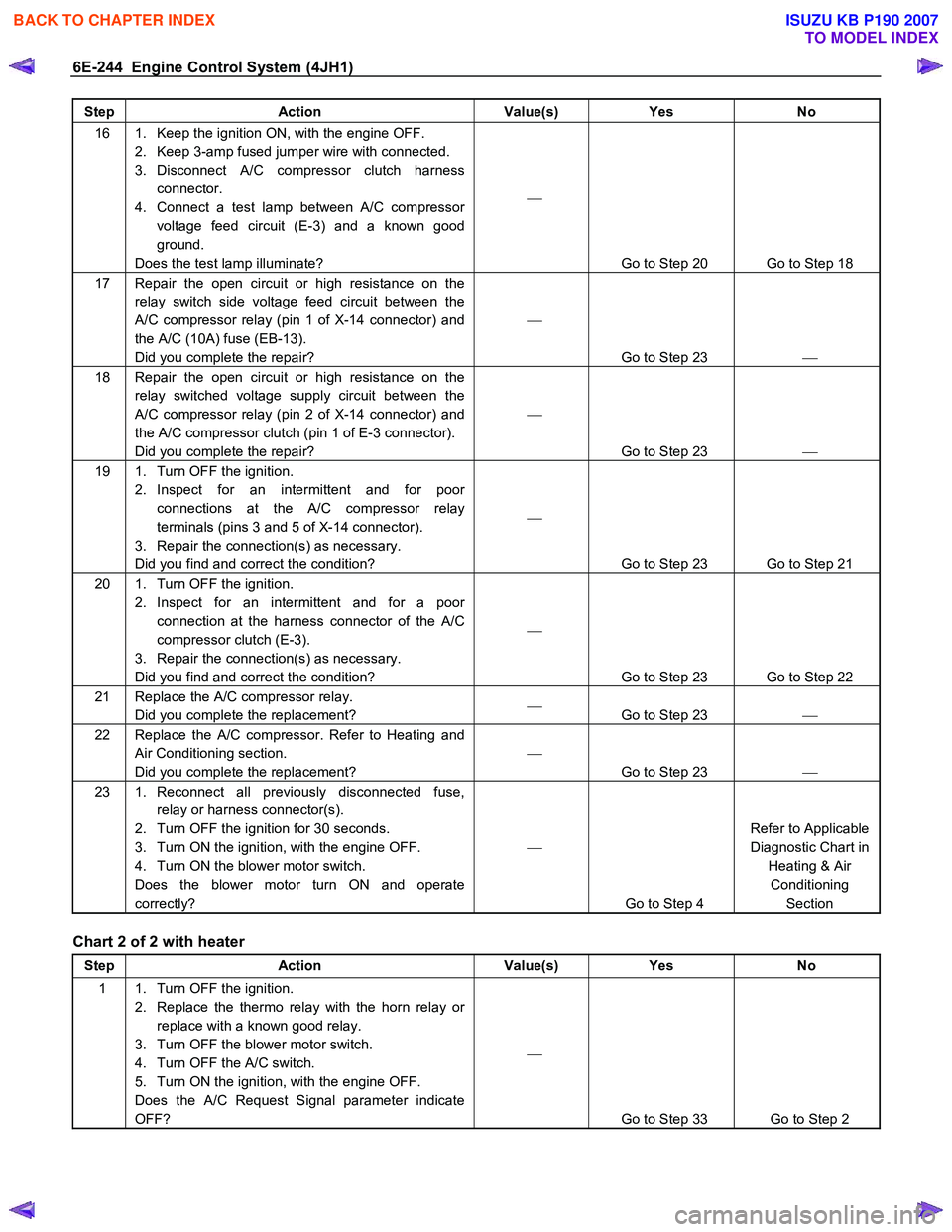
6E-244 Engine Control System (4JH1)
Step Action Value(s) Yes No
16 1. Keep the ignition ON, with the engine OFF.
2. Keep 3-amp fused jumper wire with connected.
3. Disconnect A/C compressor clutch harness connector.
4. Connect a test lamp between A/C compressor voltage feed circuit (E-3) and a known good
ground.
Does the test lamp illuminate?
Go to Step 20 Go to Step 18
17 Repair the open circuit or high resistance on the relay switch side voltage feed circuit between the
A/C compressor relay (pin 1 of X-14 connector) and
the A/C (10A) fuse (EB-13).
Did you complete the repair?
Go to Step 23
18 Repair the open circuit or high resistance on the
relay switched voltage supply circuit between the
A/C compressor relay (pin 2 of X-14 connector) and
the A/C compressor clutch (pin 1 of E-3 connector).
Did you complete the repair?
Go to Step 23
19 1. Turn OFF the ignition.
2. Inspect for an intermittent and for poor connections at the A/C compressor relay
terminals (pins 3 and 5 of X-14 connector).
3. Repair the connection(s) as necessary.
Did you find and correct the condition?
Go to Step 23 Go to Step 21
20 1. Turn OFF the ignition. 2. Inspect for an intermittent and for a poor connection at the harness connector of the A/C
compressor clutch (E-3).
3. Repair the connection(s) as necessary.
Did you find and correct the condition?
Go to Step 23 Go to Step 22
21 Replace the A/C compressor relay. Did you complete the replacement?
Go to Step 23
22 Replace the A/C compressor. Refer to Heating and
Air Conditioning section.
Did you complete the replacement?
Go to Step 23
23 1. Reconnect all previously disconnected fuse,
relay or harness connector(s).
2. Turn OFF the ignition for 30 seconds.
3. Turn ON the ignition, with the engine OFF.
4. Turn ON the blower motor switch.
Does the blower motor turn ON and operate
correctly?
Go to Step 4 Refer to Applicable
Diagnostic Chart in Heating & Air Conditioning Section
Chart 2 of 2 with heater
Step Action Value(s) Yes No
1 1. Turn OFF the ignition.
2. Replace the thermo relay with the horn relay or replace with a known good relay.
3. Turn OFF the blower motor switch.
4. Turn OFF the A/C switch.
5. Turn ON the ignition, with the engine OFF.
Does the A/C Request Signal parameter indicate
OFF?
Go to Step 33 Go to Step 2
BACK TO CHAPTER INDEX
TO MODEL INDEX
ISUZU KB P190 2007
Page 2002 of 6020

6-2 ENGINE DIAGNOSIS (C24SE)
Engine Diagnosis
Hard Starting
1.Starting Motor Does Not Turn Over
Trouble Shooting Procedure
Turn on headlights and starter switch.
Condition Possible cause Correction
Headlights go out or dim
considerably Battery run down or under
charged Recharge or replace battery
Terminals poorly connected Clean battery posts and terminals
and connect properly
Starting motor coil circuit shorted Overhaul or replace
Starting motor defective Overhaul or replace
2.Ignition Trouble - Starting Motor Turns Over But Engine Does Not Start
Spark Test Disconnect a high tension cable from any spark plug.
Connect the spark plug tester (use commercially
available tool), crank the engine, and check if a spark is
generated in the spark plug tester. Before cranking the
engine, make sure that the spark plug tester is properly
grounded. To avoid electrical shock, do not touch the
high tension cable while the engine is running.
Condition Possible cause Correction
Spark jumps across gap Spark plug defective Clean, adjust spark gap or replace
Spark plug wire in correct Connect properly or replace
Ignition timing incorrect Refer to Ignition System
Fuel not reaching fuel injector(s)
or engine Refer to item 3 (Trouble in fuel
system)
Valve timing incorrect Adjust
Engine lacks compression Refer to item 4 (Engine lacks
compression)
No sparking takes place Ignition coil disconnected or
broken Connect properly or replace
Electronic Ignition System with
module Replace
Poor connections in engine
harness Correct
Engine Control Module cable
disconnected or defective Correct or replace
BACK TO CHAPTER INDEX
TO MODEL INDEX
ISUZU KB P190 2007
Page 2141 of 6020
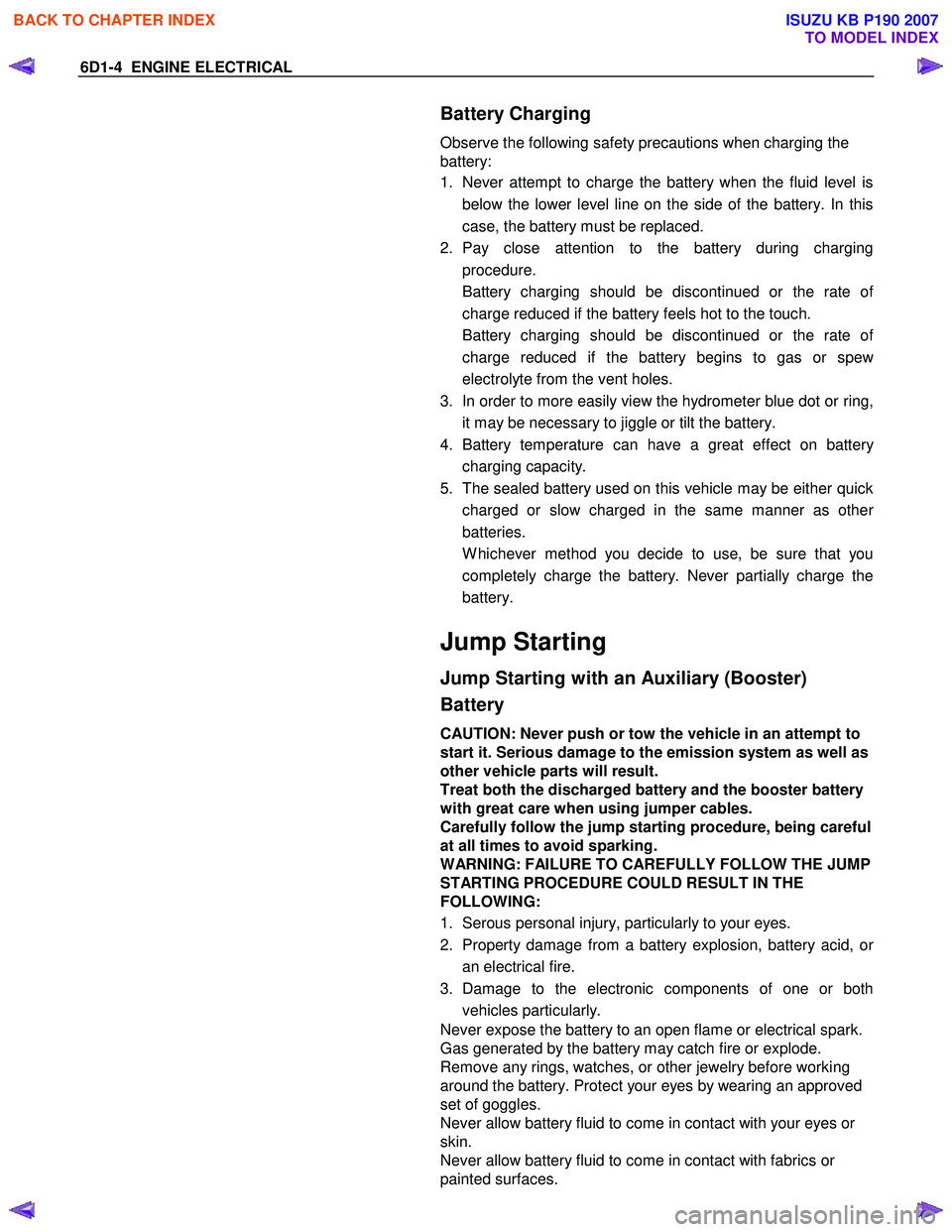
6D1-4 ENGINE ELECTRICAL
Battery Charging
Observe the following safety precautions when charging the
battery:
1. Never attempt to charge the battery when the fluid level is
below the lower level line on the side of the battery. In this
case, the battery must be replaced.
2. Pay close attention to the battery during charging procedure.
Battery charging should be discontinued or the rate o
f
charge reduced if the battery feels hot to the touch.
Battery charging should be discontinued or the rate o
f
charge reduced if the battery begins to gas or spew
electrolyte from the vent holes.
3. In order to more easily view the hydrometer blue dot or ring, it may be necessary to jiggle or tilt the battery.
4. Battery temperature can have a great effect on batter
y
charging capacity.
5. The sealed battery used on this vehicle may be either quick charged or slow charged in the same manner as othe
r
batteries.
W hichever method you decide to use, be sure that you completely charge the battery. Never partially charge the
battery.
Jump Starting
Jump Starting with an Auxiliary (Booster)
Battery
CAUTION: Never push or tow the vehicle in an attempt to
start it. Serious damage to the emission system as well as
other vehicle parts will result.
Treat both the discharged battery and the booster battery
with great care when using jumper cables.
Carefully follow the jump starting procedure, being careful
at all times to avoid sparking.
WARNING: FAILURE TO CAREFULLY FOLLOW THE JUMP
STARTING PROCEDURE COULD RESULT IN THE
FOLLOWING:
1. Serous personal injury, particularly to your eyes.
2. Property damage from a battery explosion, battery acid, o
r
an electrical fire.
3. Damage to the electronic components of one or both vehicles particularly.
Never expose the battery to an open flame or electrical spark.
Gas generated by the battery may catch fire or explode.
Remove any rings, watches, or other jewelry before working
around the battery. Protect your eyes by wearing an approved
set of goggles.
Never allow battery fluid to come in contact with your eyes or
skin.
Never allow battery fluid to come in contact with fabrics or
painted surfaces.
BACK TO CHAPTER INDEX
TO MODEL INDEX
ISUZU KB P190 2007